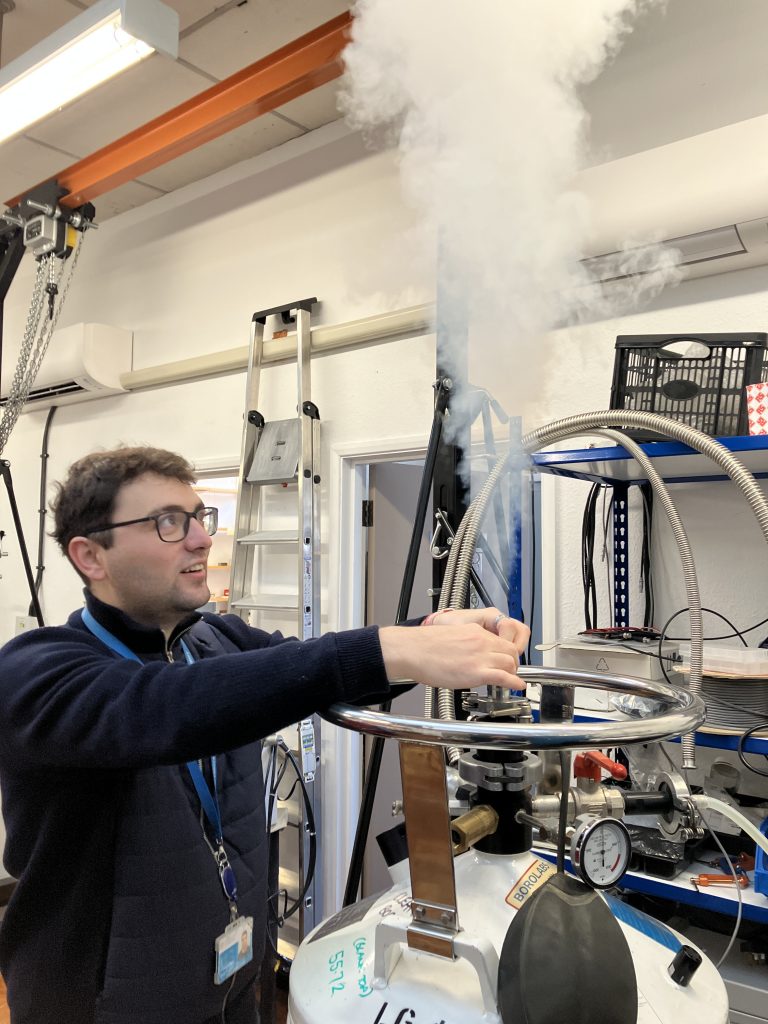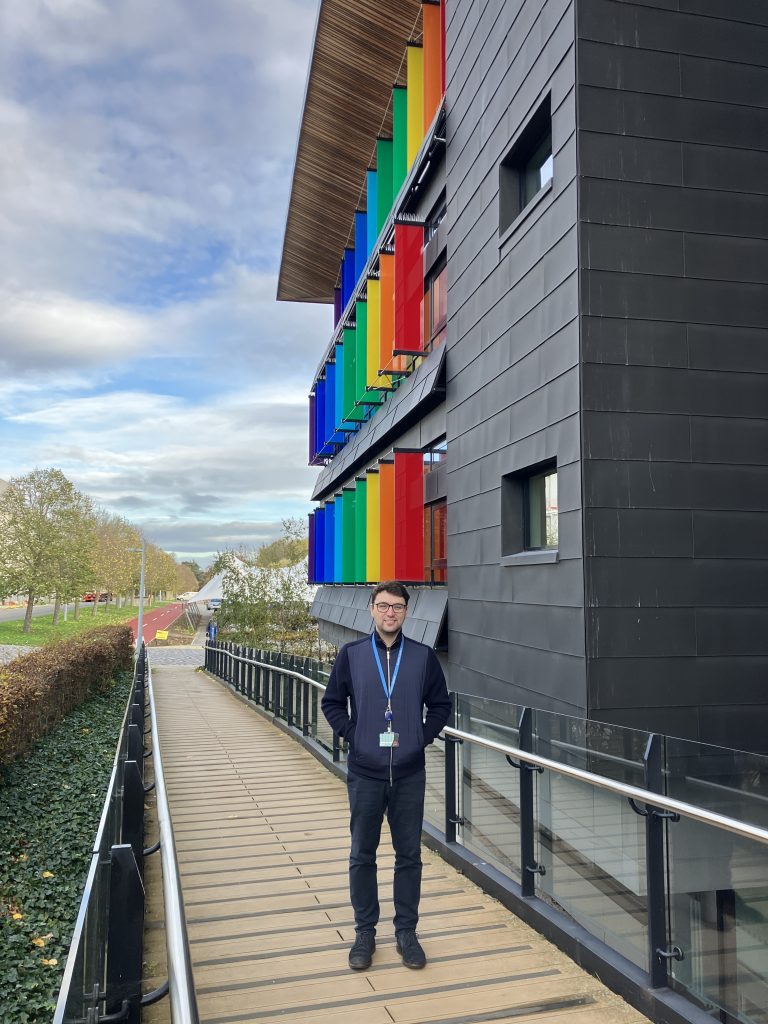Pedro Vianez
Brilliant Minds

How do we revolutionise the way the world uses energy and limit our reliance on fossil fuels? The potential of the next generation of quantum materials that will help to solve this problem is being explored by Postdoctoral Researcher Pedro Vianez at the Integrated Quantum Materials group in the Cavendish Laboratory Department of Physics, University of Cambridge.
Background
After studying his Bachelor of Science at the University of Porto in Portugal he moved to the UK eight years ago for his Master of Science at University College London. Following this he moved to the University of Cambridge in 2017 to study a Physics PhD which he completed in December 2022, and for which he won a PhD Student Award from the Cambridge Society for the Application of Research (CSAR) and a 1st place in the UK Doctoral Researcher Awards (Life and Natural Sciences category).
His current research is funded by the Engineering and Physical Sciences Research Council (EPSRC) Doctoral Prize Award, which he won shortly before the conclusion of his PhD that enabled him to continue his research at the Cavendish.
In the past six months he has received grant awards for his work from the Henry Royce Institute, the Royal Society and the European Microkelvin Platform.
Quantum Materials for Technology
Dr Vianez is an experimentalist working on quantum materials. His aim is to use these materials to devise specific solutions for the modern world, such as finding game-changing materials that have the perfect attributes for energy storage to help transform the way we power the planet.
“I work on the next step – quantum materials at the intersection between physics, material science and engineering.”
His methodology is based on the concept that you can create a new type of material by choosing elements that provide certain properties, and then in turn see if you can exploit those properties with a series of experiments.
He said, “Most of these properties have a quantum nature to them, hence the term ‘quantum materials’. We work with a variety of different compounds and materials and analyse them under extreme conditions. By extreme I mean very low temperatures close to absolute zero, something like minus 273 Celsius. Or very high pressure, equivalent to thousands of atmospheres.”
Now that more has been discovered and understood within this field, a new generation of materials has been identified. Dr Vianez said, “We are using quantum mechanics a lot more in material design, because up until recently the progression of material science was very much a case of mixing and matching materials and hoping you would get something useful. It wasn’t purposefully designing something with an expected result, which is where we are now.”

On a day-to-day basis Dr Vianez is hands-on in the laboratory. He is currently focusing on exploring the potential of new types of materials for energy storage that could be incorporated into solar cells or batteries to provide enhanced storage and energy conversion.
He is analysing elements such as vanadium sulphides and vanadium selenides. Vanadium is a relatively abundant element, which is of critical importance for future global scale up production.
Supercapacitors
He said: “Over the past few years there has been growing interest in exploring the use of vanadium compounds for energy storage and conversion technologies. Part of this is due to vanadium’s excellent performance in electrochemistry, both as an electrode material – in metal-ion batteries for example – or as a supercapacitor.
“As we move away from relying on fossil fuels, supercapacitors will play a key role in helping us to switch to cleaner energy solutions.”
Supercapacitors are far more versatile than batteries because they can rapidly store, convert and discharge electrical energy. They also have a much longer life than batteries, which can only be charged or discharged a certain number of times before becoming spent.
Dr Vianez said, “Our current battery technology is outdated and inefficient. If you have a metal and you pass current through it, normally it will warm up. That heat is wasted energy, for instance when a computer is used for too long it gets too warm and fans are activated, wasting even more energy.
“With superconductors energy isn’t wasted as heat because they offer no resistance to the flow of electricity. Some of the more powerful magnets are made from superconductors, such as the materials in an MRI machine (effectively a giant superconducting magnet) or in power grids. These materials have many interesting properties for conducting, as well as other properties like new forms of magnetism, which could be exploited for energy purposes.”
He added: “I’m looking at materials and how they react. We do things like cooling them down while applying very high pressures – if you start to compress something like a crystal you can slightly alter the structure so that the properties start to change.
“We do all of these things to try and characterise the behaviour of what we call thermoelectrics. This is another class of materials we work with which we can use to convert, for instance, wasted heat into electricity.”
With his current research Dr Vianez and his team are particularly interested in energy storage and production in large-scale facilities. The ideal scenario would be to have cheaper and longer-lasting systems in order to reduce waste and even widen their applications to areas on the planet which have limited access to energy.
“If you have good storage systems then you start to solve other problems, such as providing energy to parts of the world where there is no energy infrastructure.”
Working in Cambridge
Dr Vianez ended up in Cambridge almost by accident. When working on his master’s and considering his PhD, he had an interview at the National Physical Laboratory in Teddington. A serendipitous meeting led him to Cambridge.
He said, “As a scientist the West Cambridge site is very nice. I’m based in the Cavendish Laboratory and across the road we have the Royce Institute and the Maxwell Centre where we can also go and test materials. Down the road towards the University Sports Centre is the Department of Material Science. All the people and equipment we need to work with are within walking distance.

Living in Eddington
Dr Vianez has been in Eddington since May 2022 and has thoroughly enjoyed it. From a practical perspective it’s ideal because his workspace is just across the road. He said, “I can walk to work every day, which is really nice. I’ve enjoyed Eddington, everything that I need is there. It’s a really nice change from my previous accommodation.”
“I like how sustainability was taken into account with the design of the neighbourhood. It’s already winter and I haven’t had to turn on my heating yet!”
With the environmental challenges facing humanity, scientists like Dr Vianez are working hard to find practical solutions to help us forge a greener world with new ways of providing energy that don’t cost the earth.